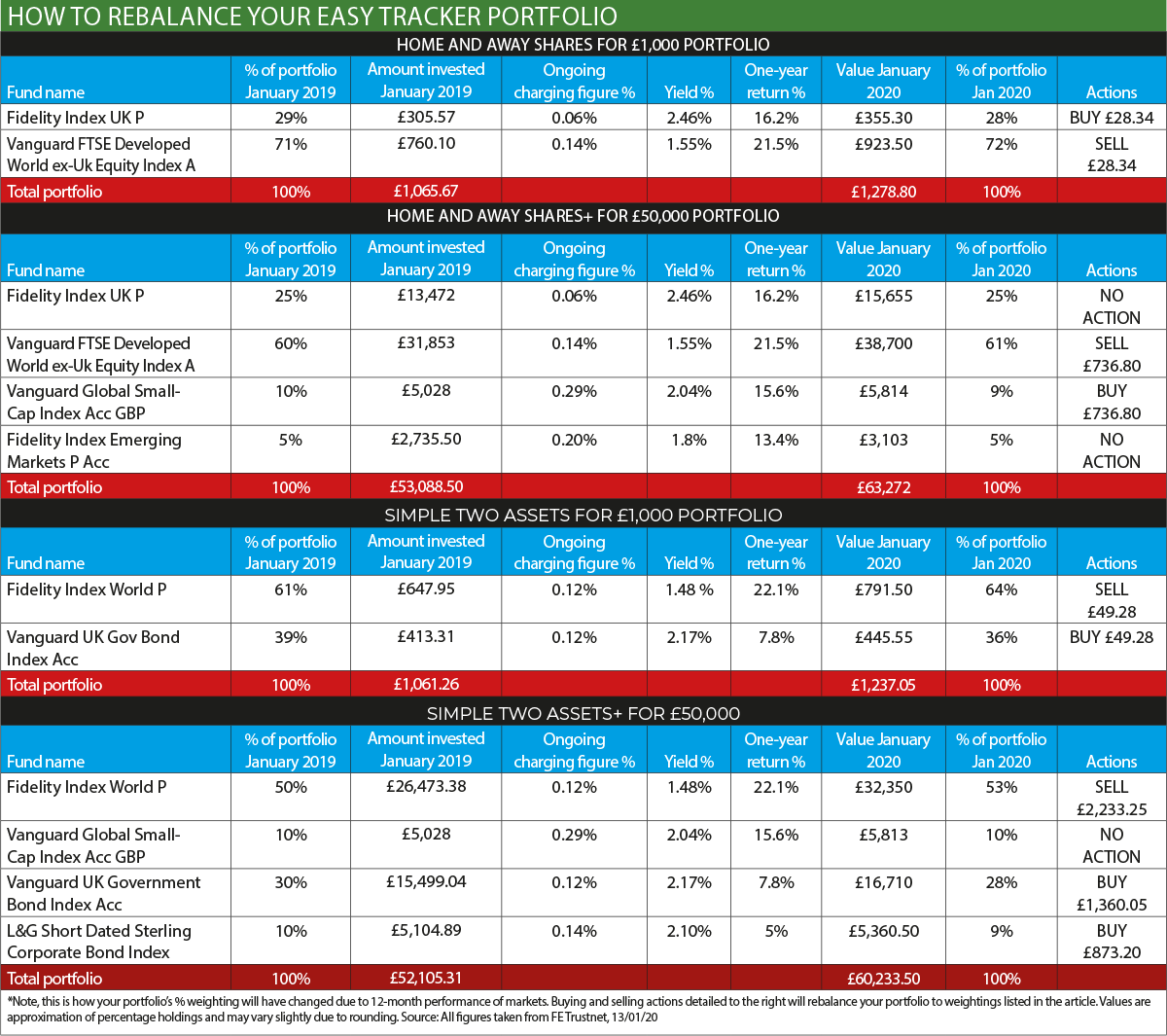Moneywise's ready-made and cheap portfolios for beginner investors
Would you like to create your own investment portfolio using simple and cheap tracker funds? Moneywise h…
23rd January 2020 14:51
by Moneywise Team from interactive investor
Would you like to create your own investment portfolio using simple and cheap tracker funds? Moneywise has done the legwork for you, with our pick of five different scenarios depending on where you start from and your appetite for risk

Last year brought welcome relief for investors after the turmoil, and losses, of 2018. Global stock markets posted their best year since the 2008/09 financial crisis. Affordable tracker portfolios, like the ones overleaf, benefited significantly from the bounce at a very low cost to investors. Here is our guide to how to get started with a cheap, effective, well-diversified portfolio.
What are tracker funds?
Tracker funds are a highly affordable way to invest in stock markets. The funds are designed to track the performance of major stock market indices, such as the FTSE 100 or S&P 500, as closely as possible.
As managers of the fund are not paid to handpick shares to try to beat the index, management costs, expressed as the ‘ongoing charges figures’ (OCF), typically remain very low.
Focusing on the cost of your investments is critical. You will usually face two charges: the OCF and the platform fee. While the markets you invest in are critical, so is checking the costs of any funds or investment platforms you are considering. Combined, these costs can put a significant dampener on the growth of your money.
How we pick the funds
Moneywise maintains a select list of 50 top-grade investment funds that work well for beginners, or those who want to consistently have a selection of best-in-class investments in their portfolio. Visit www.moneywise.co.uk/moneywise-first-50-funds for details.
To choose affordable tracker funds, we work in conjunction with our parent company interactive investor’s ‘Super 60’ list of top-rated funds, and our sister brand Money Observer’s Rated Funds list.
We choose the funds that are the most cost-effective and diversify the portfolios between equities and bonds to provide a balanced growth strategy.
How to use this guide
This is the Moneywise Easy Tracker Portfolio guide’s fourth year. If you used the portfolios as a guide for your own investment pot from the beginning and tracked the changes in 2018, check the table above to see what you need to do to rebalance your portfolio to its original weighting.
If you are new to investing and you would like help getting started, you can buy the funds we recommend and balance the portfolio you pick based on the percentages we outline above.

The Moneywise Easy Tracker Portfolios
Moneywise has selected these investment portfolios based on five different scenarios. However, if you are unsure which scenario is relevant to you, or your situation is more complex, it is worth speaking to an independent financial adviser for more detailed, personalised advice.
INSTANT PORTFOLIO FUNDS
For those who don’t want to pick their own portfolios, investment firm Vanguard offers ready-made investment portfolio funds.
These funds pick from a selection of other funds diversified as if they were an entire portfolio. As such, you can just buy one fund and stick with it.
100% – Vanguard LifeStrategy 100% Equity A Acc
This fund is a globally diverse tracker made up of other investment funds. It is a ready-made portfolio designed for investors looking at a long-term plan for growth over more than 10 years. While holding 100% equities in your portfolio is riskier, especially in volatile markets, in the long term it should yield much stronger growth as markets rise.
OCF: 0.22%
100% – Vanguard LifeStrategy 60% Equity A Acc. 40% bonds
This fund is a more conservative option, comprising 60% stocks and 40% bonds. It is a whole portfolio solution for someone with a shorter investment horizon, but still looking for solid medium-term growth.
OCF: 0.22%
HOME AND AWAY SHARES
A shares-only portfolio for someone with a high appetite for risk or a long investment timeframe of 10 years or more and £1,000 to invest.
30% Fidelity Index UK P
Fidelity Index UK P tracks the FTSE All-Share Index. It will mirror the performance of all the stock market-listed companies in the UK and is very good value, charging just 0.06% OCF. OCF – 0.06%
70% – Vanguard FTSE Developed World ex-UK Equity Index A Acc
This fund tracks the performance of stock markets in the developed world, excluding the UK.
OCF – 0.14%
HOME AND AWAY SHARES+
This portfolio is for someone with a larger portfolio of £50,000-plus, who has time to keep track of more funds or who has some experience of investing.
25% Fidelity Index UK P
60% Vanguard FTSE Developed World ex-UK Equity Index A Acc
10% Vanguard Global Small-Cap Index Acc GBP
This fund tracks the MSCI Global Small Cap index by investing in all of its 4,321 securities.
OCF – 0.29%
5% Fidelity Index Emerging Markets P Acc
This fund tracks the performance of smaller companies around the world, focusing on major economies. Smaller companies are often a good diversifier in a wider portfolio but can be subject to more volatile performance.
OCF – 0.2%
SIMPLE TWO ASSETS
This portfolio is suitable for a medium-risk, long-term investor with five years or more to invest, or for someone who is nearing retirement or is already retired who has £1,000 to invest.
60% Fidelity Index World Fund P
This fund tracks the performance of the MSCI World Index, comprising a mixture of stocks from major global economies and is very well diversified.
OCF – 0.12%
ALTERNATIVE
60% iShares Core MSCI World UCITS ETF
The Fidelity Index World Fund P above does not appear on Money Observer’s Rated Funds list 2020. The iShares Core MSCI World UCITS ETF does. It also tracks the MSCI World index. You could consider this as an alternative if you would prefer a fund on the Rated Funds list. Since they offer the same exposure, you may not think it worth swapping if you are already invested in the Fidelity fund.
OCF – 0.2%
40% Vanguard UK Gov Bond Index Acc
This bond fund is designed to achieve lower-risk diversity for a portfolio alongside equities. Bonds are typically much safer investments than stocks, and government bonds are the safest. This fund tracks the performance of a market-weighted bond index of UK government sterling fixed-income securities.
SIMPLE TWO ASSETS+
The portfolio would suit a medium-risk, long-term investor with a larger portfolio of £50,000-plus or a more confident investor.
50% Fidelity Index World Fund W Acc
10% Vanguard Global Small-Cap Index Fund Acc
30% Vanguard UK Government Bond Index Acc
10% L&G Short Dated Sterling Corporate Bond Index Acc
This fund tracks the total return of a sterling corporate bond index and is mostly made up of short-dated bonds with maturities from one to five years. It provides a relatively stable return compared with equities.
OCF – 0.14%
ALTERNATIVE
10% Vanguard UK Investment Grade Bond Index Inc
The L&G Short Dated Sterling Corporate Bond Index Acc is no longer on the Money Observer Rated Funds list. This Vanguard fund is and invests in more than 1,000 corporate bond issues with a credit rating of between AAA and BBB. If you are building a portfolio from scratch, you may want to consider this as an alternative.
OCF – 0.12%
A better year for investors
The Moneywise Easy Tracker Portfolios are now in their fourth year. Good market conditions mean our portfolios are up year-on-year between 14% and 20%.
While past performance cannot be used to indicate the future, over the long term, stock market indices do tend to grow as the global economy grows.
Our portfolios are designed for a five- to 10-year (and beyond) plan. If you are likely to need the cash within this horizon, then you might want to consider alternative savings products instead.
Ultimately, investing in the stock market is a long-term pursuit, not a short-term way to make money.
Moira O’Neill, head of personal finance at interactive investor, says: “Spreading your investments between different assets when building your portfolio is a sensible strategy and will often serve you well, but it’s equally important to monitor your portfolio once it’s set up.
“‘Rebalancing’ means selling some of the assets that have grown in value to buy more of those that have fallen in value. Often investors don’t like selling their winners to buy the losers, but it does make sense. Over time, an investment portfolio can become unbalanced due to the ups and downs of its constituent investments. If your riskier assets have performed well, they could make up a larger portion of your investments, which means overall your risk is higher.
“It is critical, therefore, to periodically review the balance of your holdings to ensure they continue to meet your needs and match your attitude to risk. Furthermore, by regularly rebalancing your portfolio – even if it’s only once a year – you could significantly enhance your returns.
“However, particularly if you have a small portfolio, you should watch out for any dealing fees that may be incurred when buying and selling investments to make sure they don’t wipe out any potential gains from this strategy.
“Some platforms will allow you to switch between funds without cost (though you may incur costs in other ways), while other platforms have trading fees. On larger amounts of £2,000 or more, trading fees have less impact, but be careful if you are dealing in small amounts.”
This article was originally published in our sister magazine Moneywise, which ceased publication in August 2020.
These articles are provided for information purposes only. Occasionally, an opinion about whether to buy or sell a specific investment may be provided by third parties. The content is not intended to be a personal recommendation to buy or sell any financial instrument or product, or to adopt any investment strategy as it is not provided based on an assessment of your investing knowledge and experience, your financial situation or your investment objectives. The value of your investments, and the income derived from them, may go down as well as up. You may not get back all the money that you invest. The investments referred to in this article may not be suitable for all investors, and if in doubt, an investor should seek advice from a qualified investment adviser.
Full performance can be found on the company or index summary page on the interactive investor website. Simply click on the company's or index name highlighted in the article.